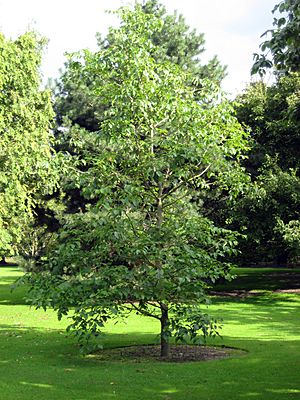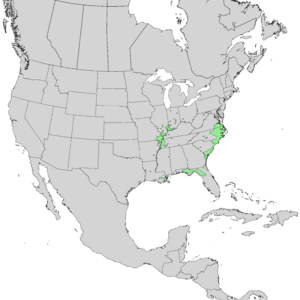Pumpkin ash facts for kids
Quick facts for kids Pumpkin ash |
|
|---|---|
 |
|
| A Pumpkin Ash tree in the Royal Botanic Garden Edinburgh | |
| Conservation status | |
| Scientific classification | |
| Genus: |
Fraxinus
|
| Species: |
profunda
|
 |
|
| Where Fraxinus profunda naturally grows | |
 |
|
| A closer look at where Fraxinus profunda grows | |
| Synonyms | |
|
Fraxinus tomentosa F.Michx. |
|
The pumpkin ash (scientific name: Fraxinus profunda) is a type of ash that grows naturally in eastern North America. You can find it mainly in the United States, especially in the Atlantic coastal plain and along rivers. It also grows a little bit in southern Canada, in Essex County, Ontario.
Pumpkin ash trees love to grow in swampy areas. They are very important for the environment and for people. Sadly, the pumpkin ash is currently in danger from a bug called the emerald ash borer. This bug is a big threat to all ash trees in North America. The fruits of the pumpkin ash tree are the biggest of all ash trees in eastern North America.
Contents
About the Pumpkin Ash Name
The pumpkin ash tree belongs to the Oleaceae family, which also includes olive trees. It was first described by a botanist named Benjamin Franklin Bush in 1901.
The name "pumpkin ash" comes from how the bottom of its trunk can swell up, looking a bit like a pumpkin. Other common names for this tree are red ash or swell-butt ash.
What the Pumpkin Ash Looks Like
The pumpkin ash is usually a medium-sized tree that loses its leaves in the fall (a deciduous tree). It can grow from 12 to 30 meters (about 40 to 100 feet) tall. Its trunk can be up to 1 meter (about 3 feet) wide. Some very old trees can even reach 50 meters (164 feet) tall with a trunk almost 5 meters (15 feet) wide!
The bark of the tree is gray and thick. On older trees, it has deep cracks that form a diamond pattern. The winter buds are dark brown or black and feel soft like velvet.
Its leaves grow opposite each other on the branch. Each leaf is made up of 7 to 9 smaller leaflets, like feathers. A whole leaf can be 25 to 40 cm (10 to 16 inches) long. The leaflets are 8 to 20 cm (3 to 8 inches) long and 5 to 8 cm (2 to 3 inches) wide. They have slightly jagged edges and feel soft on the underside.
Pumpkin ash trees are angiosperms, which means they produce flowers and fruits, not just seeds. The flowers appear in spring before the new leaves. They are small, purplish-green, and don't have petals. The wind helps spread their pollen.
The fruit is called a samara. It's the largest fruit of any ash tree in North America. It's 5 to 8 cm (2 to 3 inches) long and has a single seed with a long, flat wing that helps it fly in the wind.
Where Pumpkin Ash Trees Live
Pumpkin ash trees mostly grow in swamps and wet areas. These places can be tidal estuary swamps, low spots in coastal plains, or areas along rivers that flood.
You can find them from northern Florida up the east coast to southern Virginia. Some also grow in parts of Illinois, Indiana, Arkansas, and Missouri. The areas where they grow often have a lot of rain, about 100 to 120 cm (40 to 48 inches) per year.
The temperature in these areas is usually warm. In summer, it averages around 27°C (80°F) in northern states and 28°C (82°F) in southern states. In winter, temperatures range from 2°C (35°F) in the north to 15°C (60°F) in the south. These trees can handle very cold temperatures, even down to -31°C (-24°F).
Pumpkin ash trees can grow in different kinds of wet soils, from silty soil to clay soil. Even though they like wet places, they grow fastest on slightly higher ground in swamps where the water drains better.
Pumpkin Ash Life Cycle
Pumpkin ash trees can start making fruit when they are about ten years old. Their seeds grow during the summer and fall to the ground in early autumn.
The seeds are often carried by the wind. But since these trees grow in wet areas, their seeds can also float on water. They can even survive in wet conditions for many months.
When a pumpkin ash seed sprouts, the young tree grows best in moist soil where there's a lot of sunlight. It grows very quickly in open areas with bare ground. If it gets plenty of light and moisture, a young pumpkin ash can grow faster than many other tree species.
Threats to Pumpkin Ash
The pumpkin ash tree is a food source for the young (larvae) of many types of moths and butterflies. However, it is seriously threatened by a bug from Asia called the emerald ash borer (EAB).
The emerald ash borer was first found in Michigan in 2002. This tiny beetle attacks the inner bark of the pumpkin ash tree, which is how the tree gets its nutrients. The EAB can spread very quickly, wiping out ash tree populations in just six years.
Because of the emerald ash borer, the pumpkin ash was listed as "Critically Endangered" in 2017. This means its population has dropped a lot across most of its natural range. Pumpkin ash trees are also sensitive to fire.
How People and Animals Use Pumpkin Ash
Pumpkin ash trees provide important resources for both humans and animals. Birds like wood ducks eat the fruits of the tree. Deer like to eat the twigs and leaves.
People use the wood from pumpkin ash trees for building. It's also used to make tools, like handles. The wood can also be used for lumber and other wood products.
See also
 In Spanish: Fraxinus profunda para niños
In Spanish: Fraxinus profunda para niños


